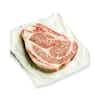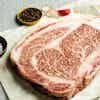



A5 Japanese Olive Wagyu Ribeye Steak Cap On
A ribeye with unparalleled umami
TASTING NOTES FROM THE CURATOR
This flavorful and tender cut is taken from the sixth through twelfth ribs of the cow’s rib section, sliced into a considerable slab, with the cap on. The cap is the upper portion of fat and meat on the ribeye, and is as equally delicious as the rest of the steak.
But it doesn’t stop there. Almost mythical in its status, the A5 Japanese Olive Wagyu Ribeye is as rare a steak as you can get. It’s almost impossible to get ahold of it—even in Japan! It comes exclusively from the Kuroge Washu (Japanese Black) breed of cattle on Shodoshima, an island in Japan known for its olive oil industry. These cattle are special, because they process fat differently. The fat is integrated into the muscle, and creates a uniquely dense marbling incomparable with other beef.
These Kuroge Washu cattle are fed upcycled, toasted olive pulp, which gives the fat a slightly light-yellow color. It also gives the meat a high amount of oleic acid, which gives it a truly incredible umami flavor, and a buttery texture like nothing else.
PREPARATION AND PAIRINGS
The best way to prepare A5 Japanese Olive Wagyu Ribeye Steak is as simply as you could. The steak is already so buttery and filled with flavor, that it honestly needs no frills or fancy trimmings. Just salt for seasoning, and no oil needed. A simple pan sear is all the technique you require. It’s not advisable to grill this high-fat steak. Grilling might result in dangerous flare-ups on your grill, and you can end up with a sad pool of melted fat.
Because of its high fat content, the A5 Japanese Olive Wagyu Ribeye Steak will need a little more time to work the salt in. Season it at least an hour before cooking. Keep it refrigerated until the moment it hits the pan. Leaving it out at room temperature will soften the fat too much and will give you a puddle of melted fat when you cook it.
Preheating your skillet in an oven is a good idea. What you want is a nice even heat, and a cool pan on a hot burner will create hotspots. Once everything is ready, place your skillet onto the burner at high heat, and sear your steak. Keep its doneness rare to medium rare.
Let it rest, and cut it into thin strips before serving. Why? Because the A5 Japanese Olive Wagyu is so rich and decadent, that you’ll only really get to eat a bit at a time.
Pair it with something light, like a salad, grilled asparagus, roasted broccoli, or sauteed spinach. You don’t want to pair it with something heavy, like potatoes, pasta, or rice.
SPECIAL FOOD, SPECIAL COWS
Olive Wagyu was invented in 2006 by Masaki Ishii, a cattle farmer in Shodoshima Island. The island was the only place olive seedlings thrived after being planted in three locations in Japan in 1908, and thus, is currently famous for its olive oil industry. Masaki Ishii wanted to make use of the olive oil production by-products from the olive oil makers, and use it as feed for his cattle. He took the olive peels and toasted them. This made them sweeter, and he mixed them with barley, grains, and rice straw; the cows loved it. He then shared this recipe with other farmers in the area, and thus, Olive Wagyu was born.
It is a very rare type of Wagyu, though, and is even difficult to get ahold of in Japan. It won Best Fat Quality against 182 other competitors in the 2017 Wagyu Olympics, which is held every five years.
Storage Instructions
Your cut of A5 Japanese Olive Wagyu comes frozen and vacuum packed. Store in freezer. Thaw only when about to cook. Cooked leftover meat can only be kept in the fridge for 3 to 4 more days. Consume immediately.





